胃癌分子分型研究进展
胃癌分子机制研究新进展
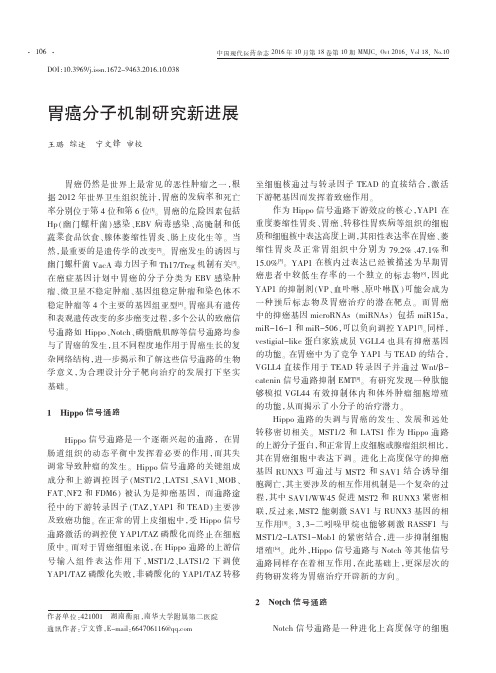
中国现代医药杂志2016年10月第18卷第10期MMJC ,Oct 2016,Vol 18,No.10作者单位:421001湖南衡阳,南华大学附属第二医院通讯作者:宁文锋,E-mail :664706116@胃癌仍然是世界上最常见的恶性肿瘤之一,根据2012年世界卫生组织统计,胃癌的发病率和死亡率分别位于第4位和第6位[1]。
胃癌的危险因素包括Hp (幽门螺杆菌)感染、EBV 病毒感染、高腌制和低蔬菜食品饮食、腺体萎缩性胃炎、肠上皮化生等。
当然,最重要的是遗传学的改变[2]。
胃癌发生的诱因与幽门螺杆菌VacA 毒力因子和Th17/Treg 机制有关[3]。
在癌症基因计划中胃癌的分子分类为EBV 感染肿瘤、微卫星不稳定肿瘤、基因组稳定肿瘤和染色体不稳定肿瘤等4个主要的基因组亚型[4]。
胃癌具有遗传和表观遗传改变的多步癌变过程,多个公认的致癌信号通路如Hippo 、Notch 、磷脂酰肌醇等信号通路均参与了胃癌的发生,且不同程度地作用于胃癌生长的复杂网络结构,进一步揭示和了解这些信号通路的生物学意义,为合理设计分子靶向治疗的发展打下坚实基础。
1Hippo 信号通路Hippo 信号通路是一个逐渐兴起的通路,在胃肠道组织的动态平衡中发挥着必要的作用,而其失调常导致肿瘤的发生。
Hippo 信号通路的关键组成成分和上游调控因子(MST1/2、LATS1、SAV1、MOB 、FAT 、NF2和FDM6)被认为是抑癌基因,而通路途径中的下游转录因子(TAZ ,YAP1和TEAD )主要涉及致癌功能。
在正常的胃上皮细胞中,受Hippo 信号通路激活的调控使YAP1/TAZ 磷酸化而终止在细胞质中。
而对于胃癌细胞来说,在Hippo 通路的上游信号输入组件表达作用下,MST1/2、LATS1/2下调使YAP1/TAZ 磷酸化失败,非磷酸化的YAP1/TAZ 转移至细胞核通过与转录因子TEAD 的直接结合,激活下游靶基因而发挥着致癌作用。
胃癌病理分型研究进展
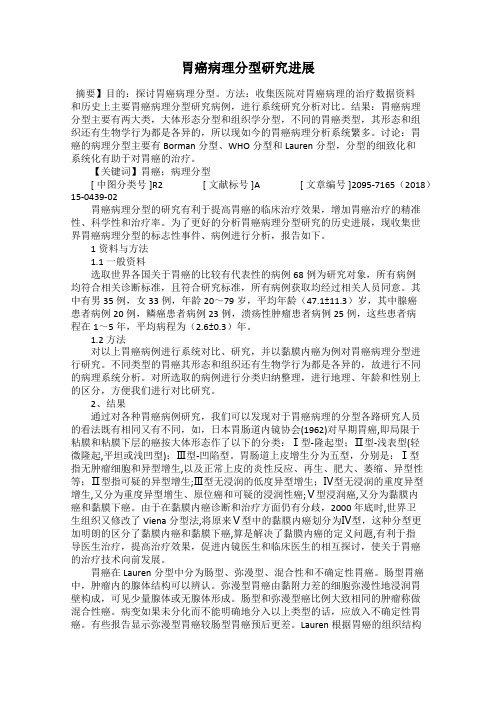
胃癌病理分型研究进展摘要】目的:探讨胃癌病理分型。
方法:收集医院对胃癌病理的治疗数据资料和历史上主要胃癌病理分型研究病例,进行系统研究分析对比。
结果:胃癌病理分型主要有两大类,大体形态分型和组织学分型,不同的胃癌类型,其形态和组织还有生物学行为都是各异的,所以现如今的胃癌病理分析系统繁多。
讨论:胃癌的病理分型主要有Borman分型、WHO分型和Lauren分型,分型的细致化和系统化有助于对胃癌的治疗。
【关键词】胃癌;病理分型[ 中图分类号 ]R2[ 文献标号 ]A[ 文章编号 ]2095-7165(2018)15-0439-02胃癌病理分型的研究有利于提高胃癌的临床治疗效果,增加胃癌治疗的精准性、科学性和治疗率。
为了更好的分析胃癌病理分型研究的历史进展,现收集世界胃癌病理分型的标志性事件、病例进行分析,报告如下。
1资料与方法1.1一般资料选取世界各国关于胃癌的比较有代表性的病例68例为研究对象,所有病例均符合相关诊断标准,且符合研究标准,所有病例获取均经过相关人员同意。
其中有男35例,女33例,年龄20~79岁,平均年龄(47.1±11.3)岁,其中腺癌患者病例20例,鳞癌患者病例23例,溃疡性肿瘤患者病例25例,这些患者病程在1~5年,平均病程为(2.6±0.3)年。
1.2方法对以上胃癌病例进行系统对比、研究,并以黏膜内癌为例对胃癌病理分型进行研究。
不同类型的胃癌其形态和组织还有生物学行为都是各异的,故进行不同的病理系统分析。
对所选取的病例进行分类归纳整理,进行地理、年龄和性别上的区分,方便我们进行对比研究。
2、结果通过对各种胃癌病例研究,我们可以发现对于胃癌病理的分型各路研究人员的看法既有相同又有不同,如,日本胃肠道内镜协会(1962)对早期胃癌,即局限于粘膜和粘膜下层的癌按大体形态作了以下的分类:Ⅰ型-隆起型;Ⅱ型-浅表型(轻微隆起,平坦或浅凹型);Ⅲ型-凹陷型。
胃肠道上皮增生分为五型,分别是:Ⅰ型指无肿瘤细胞和异型增生,以及正常上皮的炎性反应、再生、肥大、萎缩、异型性等;Ⅱ型指可疑的异型增生;Ⅲ型无浸润的低度异型增生;Ⅳ型无浸润的重度异型增生,又分为重度异型增生、原位癌和可疑的浸润性癌;Ⅴ型浸润癌,又分为黏膜内癌和黏膜下癌。
胃癌的分子机制研究进展如何

胃癌的分子机制研究进展如何胃癌是全球范围内常见的恶性肿瘤之一,其发病率和死亡率一直居高不下。
深入了解胃癌的分子机制对于改善诊断、治疗和预防策略具有至关重要的意义。
近年来,随着分子生物学技术的飞速发展,胃癌的分子机制研究取得了显著的进展。
一、基因层面的改变1、癌基因的激活原癌基因的突变或过表达在胃癌的发生发展中扮演着重要角色。
例如,HER2 基因的扩增和过表达在部分胃癌患者中较为常见。
HER2 属于表皮生长因子受体家族,其异常激活可促进细胞增殖、存活和侵袭。
此外,KRAS 基因突变也在一定比例的胃癌中被检测到,激活下游信号通路,导致肿瘤细胞的恶性表型。
2、抑癌基因的失活许多抑癌基因的功能缺失与胃癌的发生密切相关。
p53 基因是最为著名的抑癌基因之一,在超过一半的胃癌中存在突变。
p53 基因突变导致其失去对细胞周期的调控和促进细胞凋亡的能力,使得细胞异常增殖和存活。
另一个重要的抑癌基因是 CDKN2A,其编码的 p16 蛋白能够抑制细胞周期进程。
CDKN2A 的失活会使细胞周期失控,增加胃癌发生的风险。
3、 DNA 错配修复基因缺陷DNA 错配修复(MMR)基因的突变会导致微卫星不稳定(MSI),这在胃癌中也较为常见。
MSI 可引起基因组的不稳定性,增加基因突变的积累,促进胃癌的发生和发展。
二、表观遗传修饰的异常1、 DNA 甲基化DNA 甲基化是一种重要的表观遗传修饰方式。
在胃癌中,许多基因的启动子区域出现高甲基化,导致基因表达沉默。
例如,MLH1 基因的甲基化可导致 MMR 功能缺陷,引起 MSI。
此外,一些肿瘤抑制基因如 CDH1(编码 E钙粘蛋白)的甲基化也与胃癌的侵袭和转移密切相关。
2、组蛋白修饰组蛋白的乙酰化、甲基化等修饰在调控基因表达中发挥着关键作用。
在胃癌中,组蛋白修饰酶的异常表达或活性改变可导致基因表达谱的紊乱,促进肿瘤的发生和进展。
三、信号通路的异常激活1、 PI3K/AKT/mTOR 通路PI3K/AKT/mTOR 通路在细胞生长、存活和代谢等方面起着重要作用。
胃癌的分子机制及靶向诊断的最新研究进展

基础研究胃癌的分子机制及靶向诊断的最新研究进展马海军 国麟祺 何其勇佳木斯大学附属第一医院 黑龙江省佳木斯市 154002【摘 要】胃癌疾病属于临床消化道肿瘤之一,在发展中国家发病几率相对偏高。
近年来,胃癌成为我国恶性肿瘤疾病中的主要组成部分,对社会群众生命安全造成的威胁较大。
胃癌疾病与人体中得很多细胞因子与信号通路存在密切关系,部分验证因子与生长因子等参与胃癌疾病发生过程,在疾病进展过程中发挥着一定作用。
由于胃癌早期症状不明显,临床筛查诊断效果有限,因此胃癌早期诊断工作难度较大。
靶向诊断是胃癌早期诊断中的重要手段之一,能够为胃癌患者早期治疗提供参考,具有应用研究价值。
本文主要对胃癌分子机制进行研究,并对近年来最新胃癌靶向诊断研究进展进行综述。
【关键词】靶向诊断;胃癌;分子机制;研究进展从全球范围来看,虽然胃癌疾病发病率正处于下降趋势,但疾病发生率率在全身恶性肿瘤中依然占有8%,且死亡率达到10%。
因此,需要对胃癌患者进行早期诊断治疗,这对患者预后改善具有重要影响。
Chen W等[1]中国胃癌疾病进行统计研究,发现男性患者与女性患者胃癌疾病在全身恶性肿瘤中分别占据第二、第四位。
在靶向药物治疗和分子机制深入探索的过程中,胃癌靶向诊断逐渐在临床诊治中发挥作用,成为胃癌疾病诊断中的一种新兴技术。
1 胃癌分子机制β胡萝卜素、维生素E等强抗氧化物质。
(2)锻炼身体提高免疫力,慢跑、爬山、游泳等有氧运动,养成良好的生活习惯。
(3)洁身自好要有固定的性伴侣,夫妇双方同时和预防治疗。
(4)不用公共的洗浴用具。
(5)注射HPV疫苗。
5 疫苗的种类HPV 疫苗是全球第一个肿瘤疫苗,它是是预防性疫苗,是蛋白不是病毒,没有病毒功能,不会造成病毒感染。
从2016年,每年会有一款预防HPV的疫苗在我国上市,至今有三种:二价、四价和九价。
(1)二价疫苗适合9岁以上女性接种,预防HPV16、18型,预防70%的宫颈癌。
(2)四价疫苗适于9岁以上男女都可接种,预防HPV6、11、16、18型,预防70%宫颈癌和90%的生殖道疣。
胃癌分子分型的研究进展

胃癌分子分型的研究进展胃癌是一种高度异质性疾病,“一刀切”的治疗方法已难以取得令人满意的治疗结果。
随着分子检测技术的飞速发展,胃癌的研究已进入分子水平。
研究者们从遗传、表观遗传和分子特征等方面进一步阐释了胃癌的发病机制,鉴定出了新的分子亚型,为临床的个体化治疗带来了极大的希望。
但在临床中应用还十分有限,将其早日应用于临床是未来努力的方向。
[Abstract] Gastric cancer is a highly heterogeneous disease,the “one-size-fits-al l” therapeutic approach had moke it difficult to achieve satisfactory results. With the dramatic development of molecular detection technology,gastric cancer research has entered the molecular level. Researchers have further elucidated the pathogenesis of gastric cancer from the aspects of genetics,epigenetic and molecular features,and have identified new molecular subtypes,which brings great hope for clinical individualized treatment. However,their clinical application is still very limited,and its early application in clinical practice is the direction of future efforts.[Key words] Gastric cancer;Molecular classification;Molecular mechanisms;Individualized treatment;Review胃癌是最常见的恶性肿瘤之一,在全球发病率居恶性肿瘤的第五位,死亡率居恶性肿瘤的第三位[1],我国每年新增病例数和死亡人口均超过了全球的40%[2],大多数患者发现时已为不可切除的局部晚期或有全身性转移,预后较差,严重危害了人们的健康和生命。
胃癌分子分型的研究进展解析
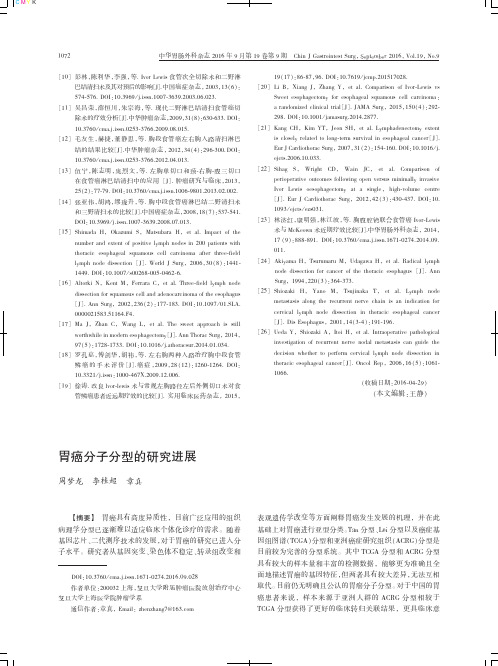
【摘要】胃癌具有高度异质性,目前广泛应用的组织病理学分型已逐渐难以适应临床个体化诊疗的需求。
随着基因芯片、二代测序技术的发展,对于胃癌的研究已进入分子水平。
研究者从基因突变、染色体不稳定、转录组改变和表观遗传学改变等方面阐释胃癌发生发展的机理,并在此基础上对胃癌进行亚型分类。
Tan分型、Lei分型以及癌症基因组图谱(TCGA)分型和亚洲癌症研究组织(ACRG)分型是目前较为完善的分型系统。
其中TCGA分型和ACRG分型具有较大的样本量和丰富的检测数据,能够更为准确且全面地描述胃癌的基因特征,但两者具有较大差异,无法互相取代。
目前仍无明确且公认的胃癌分子分型。
对于中国的胃癌患者来说,样本来源于亚洲人群的ACRG分型相较于TCGA分型获得了更好的临床转归关联结果,更具临床意[10]彭林,陈利华,李强,等.IvorLewis食管次全切除术和二野淋巴结清扫术及其对预后的影响[J].中国癌症杂志,2003,13(6):574鄄576.DOI:10.3969/j.issn.1007鄄3639.2003.06.023.[11]吴昌荣,薛恒川,朱宗海,等.现代二野淋巴结清扫食管癌切除术的疗效分析[J].中华肿瘤杂志,2009,31(8):630鄄633.DOI:10.3760/cma.j.issn.0253鄄3766.2009.08.015.[12]毛友生,赫捷,董静思,等.胸段食管癌左右胸入路清扫淋巴结的结果比较[J].中华肿瘤杂志,2012,34(4):296鄄300.DOI:10.3760/cma.j.issn.0253鄄3766.2012.04.013.[13]伍宁,陈志明,庞烈文,等.左胸单切口和颈鄄右胸鄄腹三切口在食管癌淋巴结清扫中的应用[J].肿瘤研究与临床,2013,25(2):77鄄79.DOI:10.3760/cma.j.issn.1006鄄9801.2013.02.002.[14]张亚伟,胡鸿,缪珑升,等.胸中段食管癌淋巴结二野清扫术和三野清扫术的比较[J].中国癌症杂志,2008,18(7):537鄄541.DOI:10.3969/j.issn.1007鄄3639.2008.07.013.[15]ShimadaH,OkazumiS,MatsubaraH,etal.Impactofthenumberandextentofpositivelymphnodesin200patientswiththoracicesophagealsquamouscellcarcinomaafterthree鄄fieldlymphnodedissection[J].WorldJSurg,2006,30(8):1441鄄1449.DOI:10.1007/s00268鄄005鄄0462鄄6.[16]AltorkiN,KentM,FerraraC,etal.Three鄄fieldlymphnodedissectionforsquamouscellandadenocarcinomaoftheesophagus[J].AnnSurg,2002,236(2):177鄄183.DOI:10.1097/01.SLA.0000021583.51164.F4.[17]MaJ,ZhanC,WangL,etal.Thesweetapproachisstillworthwhileinmodernesophagectomy[J].AnnThoracSurg,2014,97(5):1728鄄1733.DOI:10.1016/j.athoracsur.2014.01.034.[18]罗孔嘉,傅剑华,胡祎,等.左右胸两种入路治疗胸中段食管鳞癌的手术评价[J].癌症,2009,28(12):1260鄄1264.DOI:10.3321/j.issn:1000鄄467X.2009.12.006.[19]徐涛.改良lvor鄄lewis术与常规左胸路径左后外侧切口术对食管鳞癌患者近远期疗效的比较[J].实用临床医药杂志,2015,19(17):86鄄87,96.DOI:10.7619/jcmp.201517028.[20]LiB,XiangJ,ZhangY,etal.ComparisonofIvor鄄LewisvsSweetesophagectomyforesophagealsquamouscellcarcinoma:arandomizedclinicaltrial[J].JAMASurg,2015,150(4):292鄄298.DOI:10.1001/jamasurg.2014.2877.[21]KangCH,KimYT,JeonSH,etal.Lymphadenectomyextentiscloselyrelatedtolong鄄termsurvivalinesophagealcancer[J].EurJCardiothoracSurg,2007,31(2):154鄄160.DOI:10.1016/j.ejcts.2006.10.033.[22]SihagS,WrightCD,WainJC,etal.ComparisonofperioperativeoutcomesfollowingopenversusminimallyinvasiveIvorLewisoesophagectomyatasingle,high鄄volumecentre[J].EurJCardiothoracSurg,2012,42(3):430鄄437.DOI:10.1093/ejcts/ezs031.[23]林济红,康明强,林江波,等.胸腹腔镜联合食管癌Ivor鄄Lewis术与McKeown术近期疗效比较[J].中华胃肠外科杂志,2014,17(9):888鄄891.DOI:10.3760/cma.j.issn.1671鄄0274.2014.09.011.[24]AkiyamaH,TsurumaruM,UdagawaH,etal.Radicallymphnodedissectionforcancerofthethoracicesophagus[J].AnnSurg,1994,220(3):364鄄373.[25]ShiozakiH,YanoM,TsujinakaT,etal.Lymphnodemetastasisalongtherecurrentnervechainisanindicationforcervicallymphnodedissectioninthoracicesophagealcancer[J].DisEsophagus,2001,14(3鄄4):191鄄196.[26]UedaY,ShiozakiA,ItoiH,etal.Intraoperativepathologicalinvestigationofrecurrentnervenodalmetastasiscanguidethedecisionwhethertoperformcervicallymphnodedissectioninthoracicesophagealcancer[J].OncolRep,2006,16(5):1061鄄1066.(收稿日期:2016鄄04鄄29)(本文编辑:王静)DOI:10.3760/cma.j.issn.1671鄄0274.2016.09.028作者单位:200032上海,复旦大学附属肿瘤医院放射治疗中心复旦大学上海医学院肿瘤学系通信作者:章真,Email:zhenzhang7@163.com胃癌分子分型的研究进展周梦龙李桂超章真义。
弥漫型胃癌的分子发生学研究进展
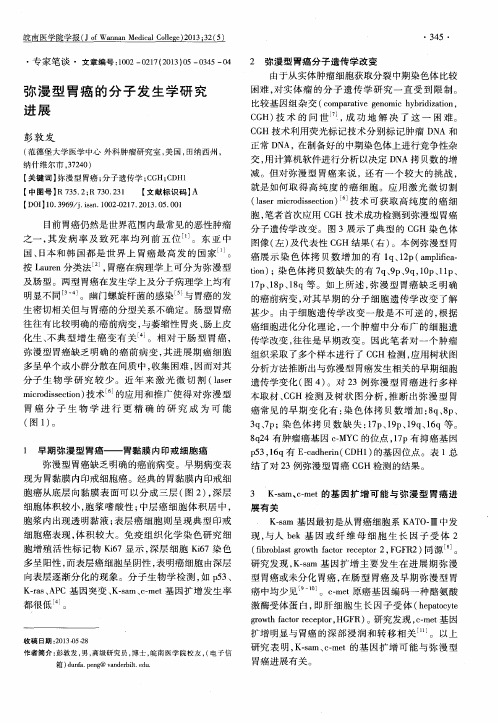
C G H) 技 术 的 问 世 , 成 功地 解 决 了 这 一 困难。 C G H技术 利用 荧光 标记 技 术 分别 标 记肿 瘤 D N A 和
目前 胃癌 仍然 是世 界 范 围内最 常见 的恶性 肿瘤
之一 , 其 发 病 率 及 致 死 率 均 列 前 五 位 J 。东 亚 中 国、 日本 和 韩 国都 是 世 界 上 胃癌 最 高 发 的 国家 J 。 按L a u r e n分 类法 l 2 J , 胃癌在 病理 学 上可 分 为 弥 漫型
皖南医学院学报 ( J o f Wa n n a n M e d i c a l C o l l e g e ) 2 0 1 3 ; 3 2 ( 5
・
3 4 5・
・
专 家笔谈 ・文章编号: 1 0 0 2 — 0 2 1 7 ( 2 0 1 3 ) 0 5— 0 3 4 5 — 0 4
纳什维尔市 , 3 7 2 4 0 )
【 关键词 】 弥漫型 胃癌 ; 分子 遗传 学 ; C G H; C D H 1 【 中图号 】 R 7 3 5 . 2 ; R 7 3 0 . 2 3 1 【 文献标识码 】 A 【 D O I 】 1 0 . 3 9 6 9 / j . i s s n . 1 0 0 2 - 0 2 1 7 . 2 0 1 3 . 0 5 . 0 0 1
及肠 型。两 型 胃癌在发 生 学上及 分 子病理 学 上均有 明显 不 同 l 3 J 。幽 门螺旋 杆菌 的感染 _ 5 与 胃癌 的发 生密 切 相关但 与 胃癌 的分 型关 系不确 定 。肠 型 胃癌 往往 有 比较 明确 的癌前 病 变 , 与 萎缩 性 胃炎 、 肠 上皮 化生 、 不 典 型增 生 癌 变 有 关 ] 。相 对 于 肠 型 胃癌 , 弥 漫 型 胃癌 缺乏 明 确 的癌 前 病 变 , 其 进 展 期 癌 细胞 多呈 单 个或小 群 分散 在 问质 中 , 收集 困难 , 因而对其
【独家解读】Nature:新型胃癌分子分型与个体化治疗前景

【独家解读】Nature:新型胃癌分子分型与个体化治疗前景胃癌,作为全球第四大常见癌和第二大致死癌,是一种发病率和致死率很高的恶性肿瘤。
每年新发胃癌近100万例,其中东亚占了一半以上。
目前胃癌的治疗方法主要包括内窥镜检切除手术、化疗或者采取放疗-化疗结合等手段。
然而,II–IV期的病人经治疗后仍然有25%-40%的复发率。
胃癌作为一种异质性疾病,一成不变的治疗措施效果有限,基于分子亚型的个性化治疗具有更好的治疗前景。
目前已有针对胃癌的几种分子分型研究,但是这些分型与临床治疗指导意义有限,不能为临床个体化治疗提供有效治疗靶点。
因此,迫切需要寻找一种新的分子分型方法,为胃癌个体化治疗和靶向药物的筛选提供依据。
目前美国的Adrey Loboda团队,Amit Aggarwal团队以及韩国的Sung Kim 团队,通过对300例原发性胃癌患者进行了多种数据分析,包括基因表达图谱分析,基因组拷贝数芯片技术和靶向测序技术,建立了一种新的胃癌分子分型方法,并分析了此分型与临床数据的相关性。
他们首先展开胃癌样本的主要组分分析,并将这些主要组分与一系列预设的基因表型特征(如表皮间质转移EMT、微卫星不稳定性、细胞因子通路、细胞增值、DNA甲基化、TP53活性等)进行比较,通过数据分析整合在分子水平将胃癌分为四个亚型:MSI亚型、MSS/EMT亚型、MSS/TP53+亚型和 MSS/TP53-亚型。
他们将上述根据亚基因表达数分型的方法应用与此前报道的胃癌人群如The Cancer Genome Atlas(TCGA)胃癌人群和新加坡人群,发现它们也存在上述四种分子分型。
研究人员进一步分析这些分子亚型与基因突变、生存率、术后复发率等临床表型之间的关系,发现了三条主线:(1)MSS/EMT亚型具有显著的更早的发病年龄,而且此亚型中80%以上人被诊断为III-IV期的弥散浸润型;(2)MSI亚型绝大多数(70%)发生在胃窦和幽门,60%以上本亚型对象具有肠亚型,而且一部分(50%)人在早期就被诊断出来(I/II期);(3)EBV病毒在MSS/TP53+ 亚型中的感染频率要高于其他三组。
胃癌分子靶向治疗的研究进展(文末有福利!)
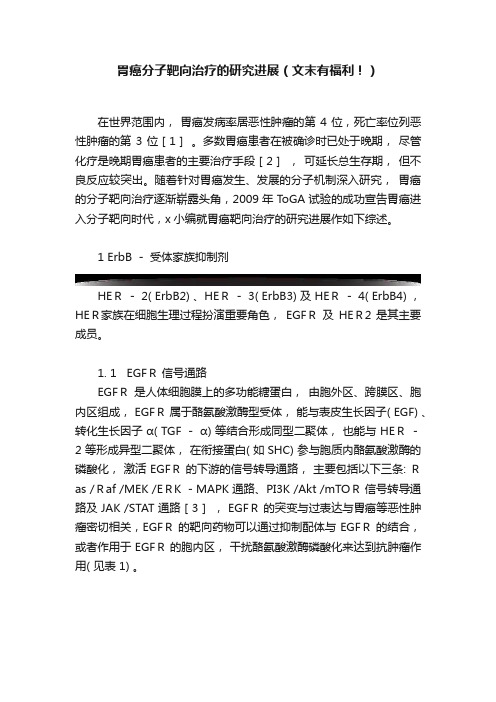
胃癌分子靶向治疗的研究进展(文末有福利!)在世界范围内,胃癌发病率居恶性肿瘤的第 4 位,死亡率位列恶性肿瘤的第 3 位[1]。
多数胃癌患者在被确诊时已处于晚期,尽管化疗是晚期胃癌患者的主要治疗手段[2],可延长总生存期,但不良反应较突出。
随着针对胃癌发生、发展的分子机制深入研究,胃癌的分子靶向治疗逐渐崭露头角,2009 年 ToGA 试验的成功宣告胃癌进入分子靶向时代,x小编就胃癌靶向治疗的研究进展作如下综述。
1 ErbB -受体家族抑制剂HER- 2( ErbB2) 、HER- 3( ErbB3) 及 HER- 4( ErbB4) ,HER家族在细胞生理过程扮演重要角色,EGFR及HER2 是其主要成员。
1. 1 EGFR信号通路EGFR是人体细胞膜上的多功能糖蛋白,由胞外区、跨膜区、胞内区组成, EGFR属于酪氨酸激酶型受体,能与表皮生长因子( EGF) 、转化生长因子α( TGF-α) 等结合形成同型二聚体,也能与 HER-2 等形成异型二聚体,在衔接蛋白( 如SHC) 参与胞质内酪氨酸激酶的磷酸化,激活 EGFR的下游的信号转导通路,主要包括以下三条: Ras /Raf /MEK /ERK -MAPK 通路、PI3K /Akt /mTOR信号转导通路及 JAK /STAT 通路[3], EGFR的突变与过表达与胃癌等恶性肿瘤密切相关,EGFR的靶向药物可以通过抑制配体与 EGFR的结合,或者作用于 EGFR的胞内区,干扰酪氨酸激酶磷酸化来达到抗肿瘤作用( 见表 1) 。
1. 1. 1 抗 EGFR单克隆抗体西妥昔单抗( cetuximab) : 西妥昔单抗是一种人鼠嵌合型 IgG1 单克隆抗体,与EGFR胞外区特异性结合,通过抗体依赖的细胞毒作用( ADCC) 杀伤肿瘤细胞, 2013 年的 EXPAND 研究[4]评价了西妥昔单抗联合XP( 卡培他滨顺铂) 方案一线治疗进展期胃癌和食管胃结合部癌的疗效; 此方案并不能改善患者的疾病无进展生存期( mPFS: 4. 4 vs 5. 6 个月) ,尽管存在Ⅱ期随机试验[5]发现西妥昔单抗联合 FOLFIRI 方案能延长转移性胃癌患者疾病进展时间( TTP) 及中位生存期( mOS) 。
胃癌的研究进展

*
病理大体分型(1) 隆起型(I型)早期胃癌 表面隆起型(IIa型)早期胃癌 凹陷型(III型)早期胃癌 混合型早期胃癌
*
*
病理大体分型(2)
单击此处添加正文,文字是您思想的提炼,为了演示发布的良好效果,请言简意赅地阐述您的观点。您的内容已经简明扼要,字字珠玑,但信息却千丝万缕、错综复杂,需要用更多的文字来表述;但请您尽可能提炼思想的精髓,否则容易造成观者的阅读压力,适得其反。正如我们都希望改变世界,希望给别人带去光明,但更多时候我们只需要播下一颗种子,自然有微风吹拂,雨露滋养。恰如其分地表达观点,往往事半功倍。
*
*
解剖学(胃的比邻关系)
上接食道贲门 右上紧邻肝 右下后紧邻十二指肠 后紧邻胰脏 左紧邻脾脏
*
*
解剖学(胃的结构)
胃的结构:胃壁从外向内由浆膜、肌层、黏膜下层和黏膜层构成
浆膜:属于腹膜脏层的一部分; 肌层:形成幽门括约肌(幽门口); 黏膜下层:为疏松结缔组织,内有丰富的血管和淋巴管; 黏膜层:厚约毫米,胃在空虚时黏膜形成许多不规则皱襞。
*
*
在肿瘤治疗中,治疗前进行准确分期、明确分期后采取最佳治疗手 段进行正确的治疗,这是最关键的环节,是正确制定治疗方案的基石, 也是获得肿瘤根治希望的所在。 影像学检查 内镜超声(EUS):为早期胃癌必查项目 PET/CT:术前分期准确率提高到68% 腹腔镜:对腹腔种植和CT无法发现的转移。检出率提高 腹腔细胞学 NCCN首次提到其在术前分期中的价值 其阳性是胃癌患者根治术后复发的独立预后因素 检测简便但存在阳性率低和假阳性的问题。有必要进一步探索
*
流行病学
而胃癌是我国的第二大常见肿瘤。 我国属胃癌较高发病区 中国胃癌男女人口死亡率 男性为20.9/10万,女性为10.2/10万 高居各类恶性肿瘤之首 存在明显城乡差异 城市:15.3/10万,农村:24.4/10万 农村是城市的1.6倍
《胃癌分子靶向治疗的研究进展》

《胃癌分子靶向治疗的研究进展》一、引言胃癌是一种常见的消化道恶性肿瘤,其发病率和死亡率均居高不下。
随着医学的进步,胃癌的治疗方法也得到了极大的发展和改善。
分子靶向治疗作为一种新型的治疗方式,在胃癌治疗中显示出巨大的潜力和优势。
本文将就胃癌分子靶向治疗的研究进展进行详细阐述。
二、胃癌分子靶向治疗概述分子靶向治疗是通过针对肿瘤细胞特有的分子改变,利用特定的药物阻断肿瘤细胞的生长、增殖和转移,从而达到治疗肿瘤的目的。
在胃癌治疗中,分子靶向治疗主要针对的是胃癌细胞中的特定分子靶点,如受体酪氨酸激酶、细胞周期调控因子、凋亡相关蛋白等。
三、胃癌分子靶向治疗的靶点研究1. 受体酪氨酸激酶:针对胃癌细胞中过度表达的受体酪氨酸激酶,如HER2、EGFR等,开发出相应的靶向药物,如曲妥珠单抗、帕尼单抗等。
这些药物能够阻断肿瘤细胞的生长信号,从而达到抑制肿瘤生长的目的。
2. 细胞周期调控因子:针对胃癌细胞周期调控因子的异常表达,如CDK4/6等,开发出相应的靶向药物,如氟维司群等。
这些药物能够阻断肿瘤细胞的增殖过程,从而达到抑制肿瘤生长的目的。
3. 凋亡相关蛋白:针对胃癌细胞凋亡相关蛋白的异常表达,如Bcl-2等,开发出相应的靶向药物,如维罗非尼等。
这些药物能够促进肿瘤细胞的凋亡过程,从而达到治疗肿瘤的目的。
四、胃癌分子靶向治疗的临床研究进展随着对胃癌分子靶点研究的深入,越来越多的分子靶向药物被应用于胃癌的临床治疗。
目前,已经有多款针对不同靶点的分子靶向药物被批准用于胃癌的治疗。
同时,许多正在进行的临床研究也在不断探索新的治疗策略和组合方案。
例如,联合使用多种靶向药物、联合使用靶向药物与化疗药物等,以提高治疗效果和减少耐药性的产生。
五、未来展望随着基因测序技术的不断发展,我们能够更准确地找出胃癌患者的分子靶点,为个体化治疗提供更加精准的依据。
同时,随着新药研发的加速和临床研究的深入,将有更多的新型分子靶向药物应用于胃癌的治疗。
胃癌的分子生物学研究进展

胃癌的分子生物学研究进展胃癌是世界上第五常见的癌症类型,也是导致世界癌症死亡人数第三多的癌症。
为了更好地了解胃癌的发生机制和寻找有效的治疗方法,科学家们一直在深入研究胃癌的分子生物学。
1. 胃癌的遗传基础研究发现,胃癌具有明显的家族聚集性,遗传因素在其发生发展中起着重要作用。
近年来,利用大规模的基因测序技术以及全基因组关联分析等方法,科学家们发现了一系列与胃癌相关的致病基因。
其中,CDH1、TP53和CTNNB1等基因的突变被广泛认为是胃癌发生的主要原因。
2. 胃癌的表观遗传学调控除了遗传性突变外,胃癌的发生和发展还受到表观遗传学的调控。
表观遗传学主要指基因组DNA甲基化、组蛋白修饰以及非编码RNA功能等调控机制。
研究发现,胃癌细胞常常存在DNA甲基化程度的变化,导致一些关键基因的表达异常。
此外,组蛋白修饰如乙酰化、甲基化、泛素化等也参与胃癌的发生与发展。
3. 胃癌的信号转导通路信号转导通路在胃癌的发生中发挥着重要作用。
研究表明,Wnt信号通路的异常激活在胃癌中很常见。
Wnt信号通路异常激活可导致β-catenin的核转位并激活其下游靶基因,促进肿瘤细胞的增殖和转移。
此外,其他信号通路如PI3K/AKT、MAPK和Notch等也与胃癌的发生密切相关。
4. 胃癌的微环境调控肿瘤微环境对胃癌的发生和发展起着重要的调控作用。
炎症反应是胃癌微环境中常见的现象,癌细胞周围的炎症细胞、细胞外基质和血管等组成了胃癌的炎症微环境。
此外,肿瘤相关的纤维化、血管生成和免疫逃逸等也对胃癌的发展具有重要影响。
5. 胃癌的治疗策略通过对胃癌分子生物学的研究,进一步推动了胃癌的个体化治疗策略的发展。
靶向治疗是近年来的研究热点,针对胃癌中发现的致病基因和异常信号通路进行精准干预。
此外,免疫治疗也显示出一定的疗效,通过激活患者自身的免疫系统来对抗胃癌。
总结起来,胃癌的分子生物学研究为我们更好地理解胃癌的发生机制提供了重要线索。
胃癌分子分型研究进展

mo l e c u l r a s t a g e , w h i c h i s a l s o a p a r t o f T C G A( T h e C nc a e r Ge n o me A t l a s ) p r o j e c t . Ul t i at m e l y , t h e y p t u
s i g n i i f c a n c e f o r c l ni i c . Th e l a t e s t ̄ s e rc a h na a ly z e d 2 9 5 p ima r r y g a s t r i c c rc a no i ma s a t c o mp r e h e n s i v e
C e n t e r , U n i o n Ho s p i t a l , T o n g iMe f d i c a l C o l l e g e , Hu a z h o n g U n i v e r s i t y o fS c i e n c e a n d T e c h n o l o g y , W u h a n
r a t e .I t s p a t h o l o g i c a l t y p e i s b a s e d o n t he mo r p h o l o g i c a l s t r u c t u r e o f t i s s u e a nd c e l l b i o l o g i c a l c h a r a c t e r i s t i c s .No t o n l y mo ph r o l o g i c a l s t rc h a r a c t e r i s t i c s b u t e p i d e mi o l o g y nd a mo l e c u l a r me c h ni a s m re a a l s o d i fe r e n t f o r e a c h t y p e ,wh i c h ma k e s s o ma n y t y p i n g s  ̄t e ms c o me o u t .
胃癌放射治疗与分子分型研究进展论文

纳人的患者超过一半为I B期或Ⅱ期,TNM分期较 早的患者具有较低的局部复发风险,可冲淡术后放 化疗带来的生存获益。其次,放疗作为一种局部治 疗手段,无法控制肿瘤的远处转移。在亚洲人群,更 具远处转移倾向的弥漫型胃癌所占比例较高,使得 术后放化疗的获益无法转化为总生存的提高一J。 以上原因皆能在ARTIST研究亚组分析的结果中得 到印证¨0|。其亚组分析显示,淋巴结阳性与肠型的
Zhen
of
Radiation Oncology,Fudan
Univemi@Shanghai
Cancer Center,Depaanvent
of Oncology,
Shanghai
Medical College,Fudan Univemi纱,Shanghai 200032,China
Corresponding author:Zhang Zhen,Email:zhenzhan96@hotmail.con
和对照组在HER-2、MET、MLHl和E—cadhefin的不
type);(3)代谢型(metabolic subtype)。2014年胃癌 TCGA分子分型¨1。的提出,具有里程碑式的意义。 该分型将胃癌分为4种亚型:(1)EBV阳性型;(2)MSI
型;(3)基因组稳定(genomically stable,GS)型;(4)染
色体不稳定(chromosomal instability,CIN)型。2015
年由亚洲癌症研究组织(Asian
Cancer Research
Group,ACRG)提出的分子分型¨4‘,也将胃癌分为4
种亚型:(1)MSI型;(2)MSS/EMT型;(3)MSS/TP53+ 型;(4)MSS/TP53-型。研究者将ACRG分型与TCGA
胃癌的分子靶向治疗研究进展

胃癌的分子靶向治疗研究进展摘要:胃癌是最为常见的一种消化道恶性肿瘤,恶性肿瘤发病率位列第五,肿瘤致死率位列第三。
化疗是胃癌最为常见的治疗手段,虽然能够起到延长患者生存时间,改善患者生活质量的目的,但是接受单纯化疗的患者中,生存时间大多维持在7个月至10个月之间。
随着对胃癌发病分子机制研究的不断深入,靶向治疗成为很多学者研究的焦点,并且很多分子靶向治疗药物已经进行了国际多中心临床试验。
ToGA研究显示,靶向HER-2的单克隆抗体曲妥珠单抗联合化疗可使HER-2阳性的进展期胃癌患者生存时间达到13.8个月。
除此之外,还有很多靶向治疗正在进行中,本文将针对近些年胃癌分子靶向治疗所取得的研究成果进行综述,以提高学者对胃癌的分子靶向治疗研究的认知程度。
关键词:胃癌靶向治疗 EGFR HER-2胃癌具有较高的发病率与死亡率,是当前对人类生命健康威胁最大的恶性肿瘤之一,根据流行病学显示,胃癌的发病与好发部位具有显著的地理差异。
东南亚地区以远端胃癌为主要发病类型,西欧与北美则是以近端胃癌和食管胃连接部腺癌为主要发病类型。
化疗是进展期胃癌患者的主要治疗手段,但是平均生存期仅10个月左右。
为了能够延长患者的生存时间,很多学者都将研究重点集中到了用药策略以及化疗方案方面。
胃癌的进展速度与驱动基因具有相关性,如果驱动基因发生改变,那么肿瘤细胞也会受到影响。
基于此,针对驱动基因的分子靶向治疗必然会起到更好的治疗效果。
从当前研究文献分析,胃癌的靶向治疗研究数量虽然较多,但是有价值的研究成果却相对较少。
本文在研究中仅仅对其中存在临床应用价值潜力的靶向治疗研究进展进行综述。
1、针对EGFR的靶向治疗1.1 西妥昔单抗西妥昔单抗是一种人/鼠嵌合型IgG1单克隆抗体,可特异性抑制EGFR与配体的结合,进而实现抑制肿瘤的生长与血管生成,诱导其凋亡的效果。
多项关于西妥昔单抗的II期临床研究初步证明,西妥昔单抗联合化疗对进展期或晚期胃癌及食管交界部腺癌具有一定的疗效和安全性[2~6]。
胃癌分子分型的研究进展
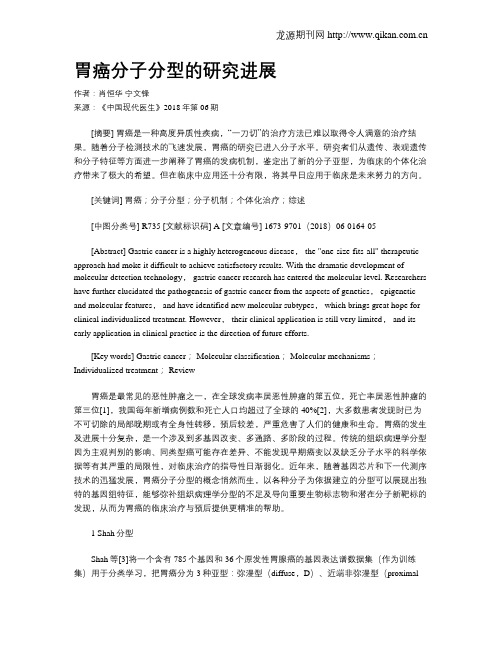
胃癌分子分型的研究进展作者:肖恒华宁文锋来源:《中国现代医生》2018年第06期[摘要] 胃癌是一种高度异质性疾病,“一刀切”的治疗方法已难以取得令人满意的治疗结果。
随着分子检测技术的飞速发展,胃癌的研究已进入分子水平。
研究者们从遗传、表观遗传和分子特征等方面进一步阐释了胃癌的发病机制,鉴定出了新的分子亚型,为临床的个体化治疗带来了极大的希望。
但在临床中应用还十分有限,将其早日应用于临床是未来努力的方向。
[关键词] 胃癌;分子分型;分子机制;个体化治疗;综述[中图分类号] R735 [文献标识码] A [文章编号] 1673-9701(2018)06-0164-05[Abstract] Gastric cancer is a highly heterogeneous disease, the "one-size-fits-all" therapeutic approach had moke it difficult to achieve satisfactory results. With the dramatic development of molecular detection technology, gastric cancer research has entered the molecular level. Researchers have further elucidated the pathogenesis of gastric cancer from the aspects of genetics, epigenetic and molecular features, and have identified new molecular subtypes, which brings great hope for clinical individualized treatment. However, their clinical application is still very limited, and its early application in clinical practice is the direction of future efforts.[Key words] Gastric cancer; Molecular classification; Molecular mechanisms;Individualized treatment; Review胃癌是最常见的恶性肿瘤之一,在全球发病率居恶性肿瘤的第五位,死亡率居恶性肿瘤的第三位[1],我国每年新增病例数和死亡人口均超过了全球的40%[2],大多数患者发现时已为不可切除的局部晚期或有全身性转移,预后较差,严重危害了人们的健康和生命。
- 1、下载文档前请自行甄别文档内容的完整性,平台不提供额外的编辑、内容补充、找答案等附加服务。
- 2、"仅部分预览"的文档,不可在线预览部分如存在完整性等问题,可反馈申请退款(可完整预览的文档不适用该条件!)。
- 3、如文档侵犯您的权益,请联系客服反馈,我们会尽快为您处理(人工客服工作时间:9:00-18:30)。
·综述·胃癌分子分型研究进展刘静文 刘红利 张涛【摘要】 胃癌是发病率及致死率较高的一种恶性肿瘤。
胃癌的病理分型是以组织形态结构和细胞生物学特性为基础,不同类型的胃癌,其形态结构和生物学行为各异,流行病学和分子机制亦不同,以致现有的胃癌病理分型系统众多。
以往常用的病理分型包括Borrmann 分型、Lauren 分型和WHO 分型,已有的这些胃癌分型对临床指导意义有限。
最新的研究对295例胃癌进行综合性分子分析,这是癌症基因组图谱(TCGA )计划工作的一部分,基于对所得数据的分析整合,提出了一种新的胃癌分子分型,将其分为四个亚型:EBV 感染型;微卫星不稳定(MSI )型;基因组稳定(GS )型;染色体不稳定(CIN )型。
该研究于2014年7月23日在《nature 》在线发表,新发现的胃癌分子分型有助于胃癌个体化治疗靶向药物的筛选。
本文将对胃癌的分子分型研究展开综述。
【关键词】 胃肿瘤; 分子分型Research progress of molecular type of gastric cancer Liu Jingwen, Liu Hongli, Zhang Tao. Cancer Center, Union Hospital, Tongji Medical College, Huazhong University of Science and Technology, Wuhan 430022, ChinaCorresponding author: Liu Hongli, Email: whliuhongli@【Abstract 】 Gastric cancer is a kind of malignant tumor which has higher incidence and mortality rate. Its pathological type is based on the morphological structure of tissue and cell biological characteristics. Not only morphological structure and biological characteristics but epidemiology and molecular mechanism are also different for each type, which makes so many typing systems come out. Usual pathological types include Borrmann type, Lauren type and WHO type. All these types have limited significance for clinic. The latest research analyzed 295 primary gastric carcinomas at comprehensive molecular stage, which is also a part of TCGA (The Cancer Genome Atlas) project. Ultimately, they put forward a new typing system which divided gastric cancer into four types including tumor positive for Epstein-Barr virus (EBV), microsatellite instable (MSI) tumors, genomically stable (GS) tumors and tumor with chromosomal instability (CIN). The study was published in the ‘nature’ online in July 23, 2014, which contributed to targeted drug screening of individualized treatment of gastric cancer. This paper reviewed the development of gastric cancer molecular type.【Key words 】 Stomach neoplasms; Molecular type1923年德国病理学家Borrmann 提出一种胃癌大体形态分型方法,称为Borrmann 分型。
此分型一、背景目前,全球每年新发胃癌100余万例,中国占42%,死亡70余万例,中国占35%。
胃癌已成为世界第三大致死癌种,在中国和日本尤为高发[1]。
以往常用的病理分型包括Borrmann 分型、Lauren 分型和WHO 分型,这几种分型均是在组织形态结构和细胞生物学特性的基础上进行。
DOI:10.3877/cma.j.issn.1674-0785.2014.24.028作者单位:430022 武汉,华中科技大学同济医学院附属协和医院肿瘤中心通讯作者:刘红利,Email: whliuhongli@主要根据癌瘤在黏膜面的形态特征和在胃壁内的浸润方式进行分类,将胃癌分为四型:Ⅰ型(结节型),Ⅱ型(溃疡局限型),Ⅲ型(浸润溃疡型),Ⅳ型(弥漫浸润型);Ⅳ型胃癌胃壁呈广泛增厚变硬,又称革囊胃。
1965年Lauren 根据胃癌的组织结构和生物学行为,将胃癌分为肠型和弥漫型,后来称为Lauren 分型[2]。
WHO 于1979年提出以组织来源及其异型性为基础的国际分型,该系统将胃癌分为腺癌(乳头状腺癌、管状腺癌、黏液腺癌、印戒细胞癌)、腺鳞癌、鳞状细胞癌、类癌、未分化癌和不能分类的癌。
1990年WHO 对胃癌组织分型进行修改,新的标准将胃癌分为上皮性肿瘤和类癌两类,上皮性肿瘤包括腺癌(乳头状腺癌、管状腺癌、低分化腺癌、黏液腺癌、印戒细胞癌)、鳞腺癌、未分化癌和不能分类癌。
然而这些分型系统临床意义小,均不能对临床个体化治疗提供有效治疗靶点,这使我们迫切的需要寻找一种新的分子分型方法,为胃癌个体化治疗靶向药物的筛选提供依据。
研究表明,大多数胃癌与感染因素有关,包括幽门螺杆菌(Helicobacter pylori,H.pylori)[3]和EB 病毒(Epstein-Barr virus,EBV)感染[4]。
少部分胃癌与E-钙黏蛋白基因(CDH1)[5]或错配修复基因(Lynch syndrome)种系突变有关,少数错配修复缺陷胃癌不表达CIMP(CpG island methylator ohenotype)中的MLH1[6]。
基于以上相关研究,已有人用基因表达谱或DNA序列来描述胃癌的分子特征,但尚未形成一个明确的分子分型系统。
2014年7月23日在《nature》在线发表的一篇论文引起研究人员的广泛关注。
作为癌症基因组图谱(The Cancer Genome Atlas,TCGA)计划工作的一部分,研究者收集了295例未接受过放化疗的原发性胃癌患者组织和血液标本,采用6种分子平台对样本进行分析,包括:(1)成组体细胞拷贝数分析;(2)全外显子序列分析;(3)成组DNA甲基化程度分析;(4)mRNA序列分析;(5)miRNA 序列分析;(6)成组反相蛋白分析(reverse-phase protein array,RPPA)。
77%的样本均进行了以上6种分子平台的检测,全部样本DNA进行了微卫星不稳定(microsatellite instable,MSI)检测,107例样本进行了低通量全基因组测序。
通过大量检测结果计算,基于对所得数据的分析整合,提出了一种胃癌分子分型,将其分为四个亚型:(1)EBV感染型,其特征包括PIK3CA频发突变、DNA超甲基化和JAK2、CD274和PDCD1LG2扩增;(2)MSI 型,其特征是高突变率,包括编码癌基因信号通路蛋白的激活性基因突变;(3)基因组稳定(genomically stable,GS)型,其特征包括多发生于组织学弥漫型中,有RHOA突变或RHO家族GTP酶活化蛋白基因融合现象;(4)染色体不稳定(chromosomal instability,CIN)型,其具有标志性的异倍染色体和受体酪氨酸激酶(Receptor Tyrosine Kinases,RTKs)原位扩增[7]。
二、EBV病毒阳性型EBV型约占9%,好发于胃底和胃体,多见于男性[8]。
研究分别采用mRNA、miRNA、外显子和全基因组序列分析来证实EBV感染,得到了高度一致的结果。
相反,仅检测到极少量H.pylori感染证据,这说明细菌感染在促进慢性胃病发展为癌的过程中所起作用不大。
检测非配对肿瘤样本CpG甲基化水平显示,EBV型有丰富的CIMP[9],这与之前的研究结果一致[10]。
EBV-CIMP和MSI相关胃- CIMP中甲基化情况的不同反映了各亚组突变谱和基因表达的不同。
EBV型的DNA超甲基化水平比任何TCGA报道过的肿瘤都要高。
EBV型都有CDKN2A(p16INK4A)启动子超甲基化。
CDKN2A 是细胞周期依赖性激酶抑制基因,为一种重要的抑癌基因,其启动子发生甲基化后会导致基因不表达,促进肿瘤发生。
但该型缺乏MSI相关CIPM的特征性MLH1启动子超甲基化[11]。
EBV型中多有PIK3CA突变[12-13],80% EBV 型发生了非无义PIK3CA突变,且其突变位点非常弥散。
相反,其他亚型中只有3%~42%的PIK3CA 突变,且突变多集中于编码激酶的外显子20处。
因此,抑制PI3K可用来证实EBV型的这一特征[7],并有可能成为该型的治疗靶点。
此外,EBV型多有ARID1A(55%)和BCOR(23%)突变,缺乏多见于CIN型的TP53突变。
ARID1A为一种抑癌基因,其突变与多种肿瘤(如卵巢癌、肝癌、胃癌和乳腺癌等)的发生相关。
BCOR编码一种抗凋亡蛋白,在白血病和髓母细胞瘤中同样可见其突变[14-15]。
研究发现了一个新的频发扩增位点,位于染色体9p24.1,包括JAK2、CD274和PDCD1LG2扩增,该扩增多发生于EBV型[7]。
JAK2编码一种RTK,是潜在的治疗靶点[16]。
CD274和PDCD1LG2分别编码免疫抑制蛋白PD-L1和PD-L2,并可能成为抗肿瘤免疫应答的治疗靶点。
CD274扩增与EBV阳性淋巴样肿瘤中有PD-L1高表达相一致[17-18]。
以上研究结果提示PD-L1/2拮抗剂和JAK2抑制剂可能对EBV型治疗有益。
